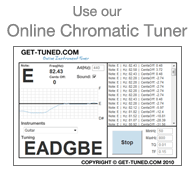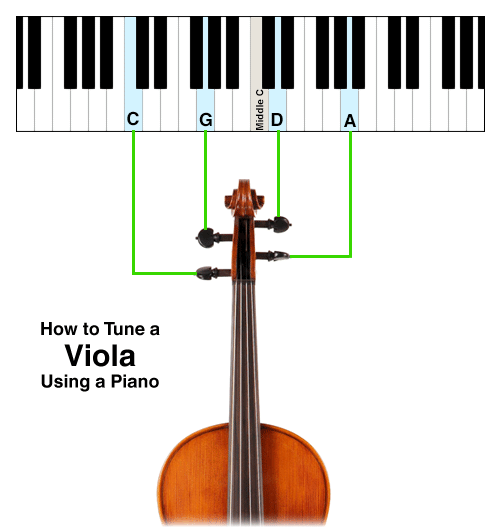How to Tune the Viola
Making sure your instrument is well tuned is important for musicians of every level. For beginners especially, tuning helps engage the ear with the specific sound and frequency of the intended note. This engagement makes it easier to translate written music on the page into the right sound. More advanced violists are encouraged to teach themselves to tune by ear, where the violist listens for the perfect fifth interval between two strings when playing them together to tune. However it is still important to have a tuner on hand, especially when playing with others.
It is important to think of the process of tuning in itself as not just an act to get the instrument ready for playing, but to get your ears and mind in tune too. A good musician will use the process of tuning as a switch to move from everyday thinking into “practice mode.” If you are a beginner, you can do this too, by using the tuning process to really listen to your viola. When you tune, think about the sound, tune, timbre, and of course the pitch of the note itself as you change the note with the fine tuners.
| Standard Viola Tuning - A4(Hz):440 | ||||
| String | Scientific pitch | Helmholtz pitch | Semitones from Middle C | Frequency (Hz) |
| C | C3 | c | -12 | 130.81 |
| G | G3 | g | -5 | 196.00 |
| D | D4 | d′ | 2 | 293.66 |
| A | A4 | a′ | 9 | 440.00 |

|

|
The viola is tuned in perfect fifths - each string is tuned an interval of a perfect fifth from the string (or strings) next to it. The strings of the viola are tightened or loosened to produce the right note by the pegs and the fine tuners. Some violas only have fine tuners on the A string, whereas others have fine tuners on all 4 strings. If you buy a viola with only one fine tuner, you do have the option of getting the other three fine tuners installed into the tailpeice by a luthier. As their name suggests, the fine tuners are used for tuning the string if the string is off-pitch by a small interval of no more than half a tone or so. When the string is out of tune by half a tone or more, then the pegs are used to tune the note initially, with the fine tuner being used afterwards to make sure the note is exactly in tune. Beginners are usually advised not to tune with the pegs unless absolutely necessary, in order to avoid unnecessary string breakages. If you are beginning to tune from the peg, it is a good idea to tune with a scientific tuner to make sure you are not over-tightening the string, however with most low-end scientific tuners you will still have to be wary of attempting to tune an octave too high or too low. When you tune with the peg, only move the peg a few millimetres at a time - you will be surprised at how significantly such a small turn can affect the pitch of the string!
- Tuning the Viola
- Tuning using a Piano
- Relative Tuning
- Alternate Tunings for the Viola
- Common Tuning Problems
- Quick-Reference Tuning Tips
Tuning the Viola
When tuning any instrument, you should always tune from below the note, up. This prevents string breakages and systematizes the process of tuning, so you eventually become more familiar with the sound of a perfect, in-tune string. When tuning your viola, you should also always tune using the fine tuners when possible (if you have them - most learner violas should have fine tuners). When a fine tuner has been wound right down to the end of the screw, loosen the fine tuner all the way to the end of the screw before carefully tightening the tuning peg. This way, you prevent the string from being over-tightened.
When you are tuning your viola, play the note continuously with your bow and listen carefully to the string as it tightens towards the desired pitch. Remember: you may need to stop to tune halfway through a practice, especially if you are using new strings as they tend to stretch and may need tightening from the peg multiple times per practice session for the first few days.
It is advisable to start by tuning the A string first, followed by the D, G then C strings. When you start to become more familiar with the sound of the notes of the different strings, you can try tuning the strings against each other - this is known as relative tuning (see 'Relative Tuning' section).
If you want to know more about the physics of tuning any instrument, head over to The Science of Tuning Musical Instruments.
Tuning using a Piano

Tuning your viola using a Piano or Keyboard is a relatively simple task. The picture below shows the piano keys that correspond with the strings on the violin. Make sure you use the 'Middle C' on the picture as a reference point so you don't try to tune your viola an octave too low, or too high. Play the note on the piano and match the correct string to the note. Remember to use the fine tuners on your viola to tune if the string is out by less than half a tone. Use the pedals on the piano so the note you play is able to sound freely, and so that you can have both hands available to tune the viola.
Relative Tuning
Relative tuning is a method of tuning the viola to itself and is a skill that requires a lot of practice and time. In the beginning, some people find it easier to hear the true pitch of the note by closing their eyes and tilting their left ear towards the F holes. You can try this too while you tune your viola. If you have seen an orchestra play live, you may have seen the orchestra pass around the A. The A string is played by the concertmaster (lead violinist) to make sure all members and sections of the orchestra are tuned properly. As a violist, you use the A that is 'passed' to you to tune your other strings. To do this, you first make sure the A string is in tune with the concertmaster, then play the A and D strings together, listening for the perfect fifth interval to ring in tune. Then play the D and G strings together, followed finally by the G and C. In order to tune like this you must have a good knowledge or what the strings sound like, and what a perfect fifth sounds like too. Perfect fifths tend to sound very resonant, so you may be able to tune this way if you listen carefully to the ringing sound, or by looking at how the strings vibrate when you play them together. Start listening for these notes when you tune as a beginner as it is a great skill to be able to identify notes by ear!
Alternate Tunings for the Viola
Generally, alternate tunings for the viola are not commonly used by violists. This is because the further away the string is tuned from the intended pitch, the worse the string works. Normal viola strings will snap if they are tuned too high, and will become too slack to play if tuned much too low. Some orchestral pieces of music require the retuning of the viola for sound projection purposes. If a viola has a solo part in an orchestra, then the strings may be tuned a semitone higher in order to produce a louder sound (as strings with increased tension will sound louder).
There are some alternative tunings for the viola if the viola is used in different genres, such as country fiddle playing. Outside of a few dozen traditional pieces however, these alternative tunings are rarely used.
If you are a beginner, you should always start learning the viola with standard tuning as standardized tuning gives you a better feel for the instrument and is easier to learn as a benchmark.
Common Tuning Problems
Pegs that slip out of place - The most common problem when tuning is pegs that slip out of place. To fix this problem try unwinding the peg a round or two and then tighten the peg again, pressing the peg reasonably hard into the peg box while turning the peg. Hopefully the peg will stick, and your viola will stay in tune!
Wound Down Fine Tuners - If you have wound the fine tuners down to the nub and they cannot screw down any further, you can fix this by first winding the fine tuner back as far as it will go without falling out. Then, tighten the string at the peg, no more than a few millimetres at a time, until the pitch is just under the open note you need. Then you can continue to tune the string at the fine tuner. This method of resetting the fine tuners will prevent the string from breaking or wearing out due to excess tightening. If you find that you over-turn the peg and the string then sounds higher than it is supposed to, you can unwind the peg slightly to fix this as you will not be able to use the unwound fine tuner to tune downwards.
If you still have difficulty with slipping pegs or if you find that your fine tuners are hard to turn then have a look at our Violin Maintenance Guide to read about what you can do to fix these problems.
Quick-Reference Tuning Tips
Tuning a viola is easy if you follow these simple tips:
Top Tip: Remember to always tune from below the note to prevent strings from overstretching and breaking.
Use the fine tuners as much as possible to prevent string breakages. When they become wound down to the nub, loosen them right the way up, use the peg to tighten the string to just below the note, and use the fine tuners to tune the note up the rest of the way. Don't over tighten the string at the peg as you will not be able to tune down with the loose fine tuners.
Tune the A string first, followed by D, G then C strings. This is how orchestral violists tune their violas. Getting into a good tuning routine helps!
If you are using a tuner then try humming the right note from the tuner first, before you tune, so you your brain knows exactly what note you are looking for. If you can't reach the note with your voice, then just visualise humming it, this has much the same effect.
If you are having technical problems (such as pegs slipping) check out our article on How to Maintain the Violin.












Turn the fine tuners right to increase pitch and left to decrease pitch right is tighter hense the sound gets higher and left is looser so the sound gets lower
waaaaaaaaaaaaaaaaaaaaaaaa
The fine tuners turn the same way as a lid on a jar: leftie/loosey and right/tighty. Just listen to the tone of the string. If you want the string to sound a bit higher in pitch, turn it to the right. The tuning pegs will cause the pitch to change very fast, so be careful that you don't snap a string. The fine tuners change the tune slightly with each turn.
It would be ideal if you have a piano or electric keyboard so you can tune your viola according to the above chart (C, D, G, A). Anyone who does not have a piano or electronic keyboard still has options. Maybe a friend has one? What about the piano at church? What about taking your viola to a piano store or music shop and tune it right there using their piano? I doubt they would mind. Just be sure to say thank you. There are also online keyboards (Google that) that mimic the sound of a piano keyboard. You can play them with the keys on your laptop or computer keyboard. They may not be perfectly in tune but it should let you get your tuning pretty close. I hope that helps. Happy playing!
Alternative tunings are and always have been used on viola. Violin, cello, and bass as well. You use the right gauge of string to match the tuning in question.
There is lots of repertoire for alternate tunings going back hundreds of years. Bach, Pagannini, many, many more.
In the early days of viola playing, players often used partial da gamba or lute tunings, tuned in 4ths, or tuned 4th-3rd-4th. Some guys today use the latter for playing rock, country, folk, especially for chord work.
Thank
Thank you. I am new to Viola. I've been playing guitar and piano for years now. This was just what I needed. Thanks.
Someone please help me
Someone please help me
Not so Helpful
This did not help as much as I thought it would and my viola is completely out of tune and I am trying to practice. I need to Practice because I am a beginner and I do not want to be the one that makes a mistake and causes the whole orchestra to fail. HELP!!!!
Thank you so much for the info! I am a beginner my self with the viola. But, what sound should it make? I don't own a piano. So.....
blank
you didn't explain how the pitch changes its volume so I reccomed you to write about the important parts of playing a viola and also mabey any tips on how to improve yourself.
What way would you turn the fine tuner if the viola is sharp?
They didn't tell you which way to turn the fine tuners.
Thanks for info